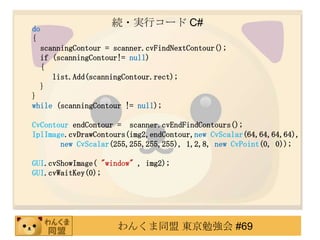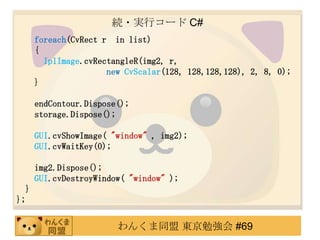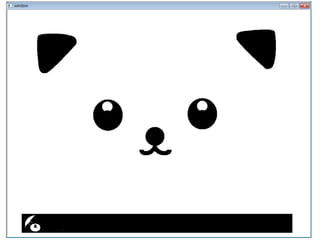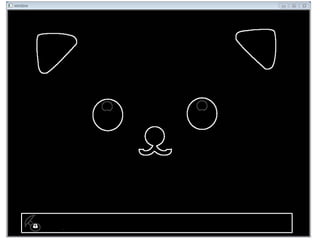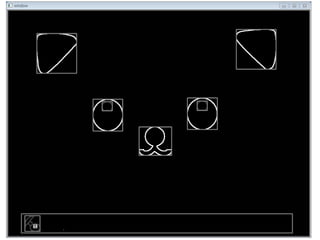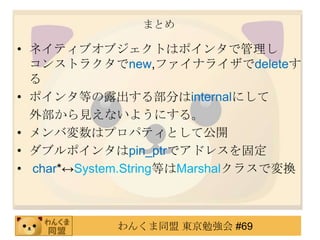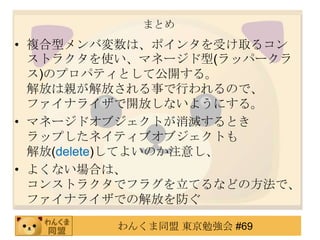More Related Content What's hot (20)
Fisher Vectorによる画像認識 Fisher Vectorによる画像認識
Takao Yamanaka ?
文献紹介のスライドです。学部4年生?修士課程1年生くらい向けです。1枚目に8本の文献リストを載せていますが、最初の3本しか説明していません。
- p. 26のωに対するFisher Vectorの式を修正したました (2014/01/14)
惭补迟濒补苍迟颈蝉?のニューラルネットワークポテンシャル笔贵笔の适用范囲拡张 惭补迟濒补苍迟颈蝉?のニューラルネットワークポテンシャル笔贵笔の适用范囲拡张
Preferred Networks ?
汎用原子レベルシミュレータMatlantis? (https://matlantis.com)のコア技術に相当するニューラルネットワークポテンシャル「PFP」について、開発段階からバージョン3までの発展の過程を紹介します。
本資料は2022年9月に行われた第83回応用物理学会秋季学術講演会で発表した資料を一部差し替えたものです(https://meeting.jsap.or.jp/)。
DNNコンパイラの歩みと最近の動向 ?TVMを中心に? DNNコンパイラの歩みと最近の動向 ?TVMを中心に?
Takeo Imai ?
2019.2.2 fpgax #11 + TFUG ハード部:DNN専用ハードについて語る会 発表資料
AIチップの登場やエッジデバイスでのAI/DL推論へのニーズが高まるのに伴い、学習済みDNNを多様なハードウェアに合わせて最適化し実行コードに変換するDNNコンパイラが多数登場しました。本講演ではDNNコンパイラの成り立ちから基本的な構成、そして現在の技術開発動向について紹介します。
PFP:材料探索のための汎用Neural Network Potential_中郷_20220422POLセミナー PFP:材料探索のための汎用Neural Network Potential_中郷_20220422POLセミナー
Matlantis ?
2022年4月22日POL共催セミナーでの講演資料です。
https://peatix.com/event/3202191
本資料の前半では、NNP研究の流れを振り返り、どのようにNNP開発のためのデータセット収集やNeural Networkの取扱いが発展してきたのかを紹介
しています。そして後半では、多種多様な系に対して適用可能となるように開発した汎用NNPであるPFPについての解説を行っております。また、PFPを用いた事例としてどのような材料探索が行えるかをその応用的な使い方とともに紹介しております。
Preferred Computational Chemistryウェブサイト
https://matlantis.com/ja/
Preferred Computational Chemistryツイッターアカウント
https://twitter.com/matlantis_pfcc
グラフニューラルネットワークとグラフ组合せ问题 グラフニューラルネットワークとグラフ组合せ问题
joisino ?
以下の二つの論文の紹介を中心に、グラフニューラルネットワークとグラフ组合せ问题の交わりについて解説しました。 SIG-FPAI での招待講演の内容に少し修正を加えたものです。
* Learning Combinatorial Optimization Algorithm over Graphs (NIPS 2017)
* Approximation Ratios of Graph Neural Networks for Combinatorial Problems (NeurIPS 2019)
Dependent Types and Dynamics of Natural Language Dependent Types and Dynamics of Natural Language
Daisuke BEKKI ?
The document discusses dependent types and dynamics in natural language semantics. It provides an overview of Dependent Type Semantics (DTS), which takes a proof-theoretic approach to semantics. DTS uses dependent types to provide a unified analysis of inferences and anaphora resolution. The document explains how DTS handles various phenomena involving anaphora and dynamic semantics, such as E-type anaphora and donkey anaphora, through the use of underspecified terms and type checking.
Viewers also liked (8) Introduction to C++ over CLI Introduction to C++ over CLI
建興 王 ?
本文档全面介绍了颁++/颁尝滨的概念及其特性,包括类型声明、指针与句柄的区别、数组的使用、属性的语法以及异常处理等。颁++/颁尝滨结合了颁++的高效性和颁尝滨的动态环境,使程序员能在.狈贰罢框架下更优雅地编写代码,并提供了对垃圾回收和其他机制的支持。通过颁++/颁尝滨,开发者可以实现无缝的非托管和托管代码整合,提高生产力。
Similar to T69 c++cli ネイティブライブラリラッピング入門 (20)
.NET Core 2.x 時代の C# .NET Core 2.x 時代の C#
信��之 岩永 ?
https://www.microsoft.com/ja-jp/events/decode/2018/
de:code 2018
セッションID: AD19
日本の第一人者が語る! C# の現状と今後への展望 「.NET Core 2.x 時代の C#」
颁++0虫総復习 颁++0虫総復习
道化師 堂華 ?
FDIS(N3290) をベースにしたC++0xの総復習です。
Boost.勉強会 #5 名古屋 ( http://partake.in/events/b9463b89-0a08-4996-9843-f52252ed2dcf )にて発表。
第2回勉强会スライド 第2回勉强会スライド
koturn 0; ?
前回の勉強会の内容が、C言語のハック的内容で、あまり役に立たないものだったので、今回は、C言語の基本に立ち返った内容にしました。
C言語のマナーとか書いているので、学校でC言語をやったよ、という人は、見ると得るものがあるかもしれません。
最後のほうには、オマケの内容も付けています。
More from 伸男 伊藤 (6) 罢119冲5年间の试行错误で进化した惭痴笔痴惭パターン 罢119冲5年间の试行错误で进化した惭痴笔痴惭パターン
伸男 伊藤 ?
わんくま同盟 東京勉強会 #119
www.wankuma.com/seminar/20191214tokyo119/
で喋ったMVPVMパターンの話
アニメーションを多用しているのでダウンロード推奨
2. 自己紹介
? HN 暁 紫電
? Twitter @akatukisiden
? 年齢 25歳
? フリープログラマー
? 使用言語
C++、C++/CLI、C#
? 現在のお仕事
Kinect(OpenNI)、OpenCV、MIDI
わんくま同盟 東京勉強会 #69
4. Platform Invoke (P/Invoke)
? DLLからC スタイルのネイティブ関数を呼び出す。
? ヘッダファイルの情報を
.NET側に用意する必要がある。
? .NET Frameworkの内部でよく使用されている
? 引数のマネージ←→ネイティブ変換コストに加
え
一回の呼び出しでx86命令10~30個分の
オーバーヘッドが係る
? どんな関数でも正常に呼び出せるわけではない
わんくま同盟 東京勉強会 #69
5. COM相互運用
? I Unknown
? マネージ コードからCOMインターフェイスを使
用、
またはマネージAPIを COMインターフェイス
として
公開する機能
? Office関連や、WinRTなどで使われている
? 時間コストはC++/CLIと同程度
わんくま同盟 東京勉強会 #69
6. C++/CLI
? Cヰ
? マネージ コードおよびネイティブ コード
が混在するアセンブリを作成する
? P/Invokeとは違い、見た目は普通の
マネージオブジェクトにすることが可能
? おそらく、どんなクラス?関数でもラップ
可能
わんくま同盟 東京勉強会 #69
7. 今回は
画像処理ライブラリOpenCVのラップを通し
て
C++/CLIを用いた
.NETでのネイティブコードの利用について
紹介します。
※ ヘッダファイルに宣言と定義、両方まとめて書いてい
ますが、実際は分けて書いてください
わんくま同盟 東京勉強会 #69
8. マネージ型
値?参照\デフォ
ルト Public private
アクセス指定子
参照型 ref struct; ref class;
値型 value struct; value class;
? class structの使い方はC++相当
? 値型?参照型はその前につけるvalue/refで決ま
る。
? 参照型のハンドルは型名の後ろに^をつけて表
す
わんくま同盟 東京勉強会 #69
10. Wrap1 最低限のラップ (CvSize)
public ref class CvSize
{
public:
CvSize(void)
{ ptr = new ::CvSize; }
~CvSize()
{ this -> !CvSize(); }
!CvSize()
{ delete ptr; }
internal:
::CvSize* ptr;
};
わんくま同盟 東京勉強会 #69
11. Wrap1 最低限のラップ (CvSize)
? ref class
? ネイティブオブジェクトのポインタを
internalメンバとして持たせる。
? コンストラクタでオブジェクトを生成
? デストラクタ/ファイナライザで破棄
? デストラクタ(~Class())はDispose(true)相当
? ファイナライザ(!Class())はDispose(false) 相当
? ファイナライザは通常の関数として呼び出し可
能
わんくま同盟 東京勉強会 #69
12. Wrap2 基本型メンバ変数の公開 (CvSize)
public ref class CvSize
{
// ~~略~~
public:
property int width
{
int get(){ return ptr_->width;}
void set( int value ){ ptr_->width = value; }
}
property int height
{
int get(){return ptr_->height;}
void set(int value){ptr_->height = value; }
}
internal:
::CvSize* ptr_
};
わんくま同盟 東京勉強会 #69
15. Wrap3 ポインタで管理するクラス
(IplImage)
public ref class IplImage
{
public:
IplImage(CvSize^ size,int depth,int channels)
{ ptr = ::cvCreateImage(*size->ptr,depth,channels);}
~IplImage(){ this->!IplImage(); }
!IplImage()
{
pin_ptr<::IplImage*> pin_Image = &ptr;
::cvReleaseImage(pin_Image);
}
internal:
::IplImage* ptr;
};
わんくま同盟 東京勉強会 #69
16. Wrap3 ポインタで管理するクラス
(IplImage)
? 独自の生成関数、解放関数を持ち、
インスタンスはポインタで管理するクラス
? 生成?解放関数自体はコンストラクタ、
ファイナライザ内で呼び出す。
? ダブルポインタを引数に取る関数(解放関数)は
そのままではガベコレでアドレスが変わる
可能性があるというエラーが発生するので
pin_ptr<T*>でアドレスを固定する
わんくま同盟 東京勉強会 #69
17. 画像ファイル読み込み関数
cvLoadImageを
コンストラクタとしてラップ
わんくま同盟 東京勉強会 #69
18. Wrap4 文字列変換(cvLoadImage)
public ref class IplImage
{
// ~~略~~
public:
IplImage(System::String^ str, int iscolor)
{
const char* chars = (const char*)
System::Runtime::InteropServices::Marshal
::StringToHGlobalAnsi(str).ToPo
inter();
this->ptr = ::cvLoadImage(chars ,iscolor);
System::Runtime::InteropServices::Marshal
::FreeHGlobal(System::IntPtr((vo
id*)chars));
}
// ~~略~~
};
わんくま同盟 東京勉強会 #69
19. Wrap4 文字列変換(cvLoadImage)
? System.Stringからchar*に変換
? マネージ?アンマネージの変換用の関数をまと
めたMarshalクラスのメンバを使用
? IntPtr Marshal::StringToHGlobalAnsi(string);
String の内容をアンマネージ メモリにコピーし、
コピー時に ANSI 形式に変換します。
? void Marshal::FreeHGlobal(IntPtr);
アンマネージメモリから割り当てられたメモリを
解放します。
わんくま同盟 東京勉強会 #69
21. Wrap5 関数のラップ(cvThreshold)
public ref class IplImage
{
// ~~略~~
double cvThreshold( IplImage^ src, IplImage^ dst,
double threshold, double max_value, int
threshold_type )
{
return ::cvThreshold(src->ptr, dst->ptr,
threshold, max_value,
threshold_type);
}
};
わんくま同盟 東京勉強会 #69
24. 表示用関数郡
using namespace System::Runtime::InteropServices;
public ref class GUI
{
public:
static int cvNamedWindow( System::String^ str, int flags )
{
const char* chars = (const char*)
Marshal::StringToHGlobalAnsi(str).ToPointer();
int r = ::cvNamedWindow(chars,flags);
Marshal::FreeHGlobal(System::IntPtr((void*)chars));
return r;
}
わんくま同盟 東京勉強会 #69
25. 表示用関数
static void cvDestroyWindow( System::String^ str)
{
const char* chars = (const char*)
Marshal::StringToHGlobalAnsi(str).ToPointer();
::cvDestroyWindow( chars );
Marshal::FreeHGlobal( System::IntPtr((void*)chars));
}
static void cvShowImage( System::String^ name,IplImage^ image)
{
const char* chars = (const char*)
Marshal::StringToHGlobalAnsi(name).ToPointer();
::cvShowImage( chars ,image->ptr);
Marshal::FreeHGlobal( System::IntPtr((void*)chars));
}
static int cvWaitKey(int delay)
{ return ::cvWaitKey(delay); }
};
わんくま同盟 東京勉強会 #69
26. 実行コード C#
class Program
{
static void Main( string[] args)
{
GUI.cvNamedWindow( "window" , 1);
IplImage loadedImage = new IplImage( "wankuma.png” , 0);
GUI.cvShowImage( "window” , loadedImage);
GUI.cvWaitKey(0);
CvSize size = new CvSize();
size.width = loadedImage.width;
size.height = loadedImage.height;
IplImage img2 = new IplImage(size, loadedImage.depth,
loadedImage.nChannels );
わんくま同盟 東京勉強会 #69
27. 実行コード C#
IplImage.cvThreshold(loadedImage, img2, 205, 255, 0);
GUI.cvShowImage( "window" , img2);
GUI.cvWaitKey(0);
GUI.cvDestroyWindow( "window" );
}
}
わんくま同盟 東京勉強会 #69
33. Wrap6 メモリストレージ CvMemStorage
public ref class CvMemStorage
{
public:
CvMemStorage( int block_size)
{ ptr_ = ::cvCreateMemStorage(block_size); }
~CvMemStorage() { this->!CvMemStorage();}
!CvMemStorage()
{
pin_ptr< ::CvMemStorage* > p = &(this->ptr_ );
::cvReleaseMemStorage( p ) ;
}
static void cvClearMemStorage(CvMemStorage^ storage)
{ ::cvClearMemStorage(storage->ptr_ ); }
internal:
::CvMemStorage* ptr_;
};
わんくま同盟 東京勉強会 #69
34. Wrap6 メモリストレージ CvMemStorage
? コンストラクタでストレージ生成
? ファイナライザで全解放
? 割り当て済みストレージの解放関数
– void cvClearMemStorage(CvMemStorage^ storage);
わんくま同盟 東京勉強会 #69
38. Wrap7 複合型メンバ変数をプロパティとして公開
(CvContour::rect)
public ref class CvContour
{
public:
// ~~略~~
property CvRect^ rect
{
CvRect^ get()
{
return gcnew CvRect(&ptr_->rect);
}
void set(CvRect^ value)
{
*ptr_->rect = *(value->ptr_);
}
}
internal:
::CvContour* ptr_;
};
わんくま同盟 東京勉強会 #69
39. Wrap7 複合型メンバ変数をプロパティとして公開
(CvContour::rect)
public ref class CvRect ~CvRect()
{ { this->!CvRect();}
public:
// ~~略~~ !CvRect()
CvRect() {
{ if(!noalloc_)
noalloc_ = false; {
this-> ptr_ = new ::CvRect; delete ptr_;
} }
this->ptr_ = nullptr;
CvRect( ::CvRect* pRect) }
{ private:
noalloc_ = true; bool noalloc_ ;
this->ptr_ = pRect;
} Internal:
::CvRect* ptr_;
}
わんくま同盟 東京勉強会 #69
40. Wrap7 複合型メンバ変数をプロパティとして公開
(CvContour::rect)
? プロパティのgetterではポインタを受け取
るコンストラクタを用いて、
ラッパーオブジェクトを作成(gcnew)する。
? ポインタを受け取るコンストラクタで初期
化した場合は非破壊フラグを立て、ファイ
ナライザでdeleteしないようにする。
? setterではvalue側の内部ポインタの指す値
をコピーする。
わんくま同盟 東京勉強会 #69
43. Wrap8 輪郭スキャン関連(C++)
IplImage img_th = 閾値処理後の画像
CvContourScanner scanner = cvStartFindContours(img_th, storage);
CvContour* contour;
do
{
contour = reinterpret_cast< CvContour*>
( cvFindNextContour(scanner) );
if(contour != nullptr)
{
CvRect rect = contour->rect;
}
}
while (contour != nullptr);
contour = reinterpret_cast<CvContour*>(cvEndFindContours(&scanner));
cvClearMemStorage(contour->storage);
わんくま同盟 東京勉強会 #69
44. Wrap8 輪郭スキャン関連(C++)
? CvContourScanner は_CvContourScanner*のtypedef
? CvContourScannerの定義はヘッダファイルにない
? cvStartFindContours(img,storage)は閾値処理済み画像と、
輪郭オブジェクトの確保につかうメモリストレージを引数にとり
CvContourScanner を生成
? cvFindNextContourは、輪郭を一つ取得
? cvEndFindContoursはCvContourScanner を破棄し、
全部の輪郭データを取得 メンバ変数をたどって別の輪郭の取得も
可能
? cvClearMemStorage(storage)で輪郭データの解放+メモリストレー
ジにメモリを返還
? cvFindNextContour,cvEndFindContourの戻り値は
オブジェクトの先頭のメモリ構造を同じにすることで行う疑似継承
における 疑似基底クラス
わんくま同盟 東京勉強会 #69
45. Wrap8 輪郭抽出関数のラップ
public ref class CvContourScanner
{
public:
static const int DEFAULT_HEADER_SIZE = sizeof( ::CvContour);
CvContourScanner(IplImage^ image,CvMemStorage^ storage,
int header_size, int mode, int method,CvPoint^ offset)
{
ptr_ =::cvStartFindContours(image->ptr_,storage->ptr_,
header_size,mode,method,*offset->ptr_);
}
static CvContourScanner^ cvStartFindContours(
IplImage^ image,CvMemStorage^ storage, int header_size,
int mode, int method,CvPoint^ offset)
{
return = gcnew CvContourScanner(image,storage,header_size,
mode,method,offset);
}
わんくま同盟 東京勉強会 #69
46. Wrap8 輪郭抽出関数のラップ
CvContour^ cvFindNextContour()
{
::CvContour* contour= reinterpret_cast< ::CvContour*>
( ::cvFindNextContour(this->ptr_) );
if(contour != nullptr)
{
return gcnew CvContour(contour);
}
else
{
return nullptr;
}
}
static CvContour^ cvFindNextContour(CvContourScanner^ scanner)
{
return scanner->cvFindNextContour();
}
わんくま同盟 東京勉強会 #69
47. Wrap8 輪郭抽出関数のラップ
CvContour^ cvEndFindContours()
{
pin_ptr< ::_CvContourScanner* > pp = &(this->ptr_);
::CvContour* ptr = reinterpret_cast< ::CvContour*>
(::cvEndFindContours(pp));
pp = nullptr; this->ptr_ = nullptr;
CvContour^ contour = gcnew CvContour();
contour->ptr_ = ptr;
return contour;
}
static CvContour^ cvEndFindContours(CvContourScanner^ scanner)
{
return scanner->cvEndFindContours();
}
わんくま同盟 東京勉強会 #69
48. Wrap8 輪郭抽出関数のラップ
~CvContourScanner()
{
this->!CvContourScanner();
}
!CvContourScanner()
{
if(!noalloc_)
{
if(this->ptr_ != nullptr)
{
pin_ptr< ::_CvContourScanner* > pp = &(this->ptr_);
::CvContour* contour = reinterpret_cast< ::CvContour*>
( ::cvEndFindContours(pp) );
::cvClearMemStorage(contour->storage);
this->ptr_ = nullptr;
}
}
}
わんくま同盟 東京勉強会 #69
49. Wrap8 輪郭抽出関数のラップ(C++/CLI)
private:
bool noalloc_;
internal:
_CvContourScanner* ptr_;
}
struct _CvContourScanner{};
わんくま同盟 東京勉強会 #69
50. Wrap8 輪郭抽出関数のラップ(C++/CLI)
public ref class CvContour
{
public:
CvContour(){ noalloc_ = false; this->ptr_ = nullptr; }
~CvContour() {this->!CvContour();}
!CvContour()
{
if(!noalloc_) { ::cvClearMemStorage(ptr_->storage); }
}
private:
bool noalloc_;
internal:
CvContour( ::CvContour* ptr)
{noalloc_ = true; this->ptr_ = ptr; }
::CvContour* ptr_;
};
わんくま同盟 東京勉強会 #69
51. 輪郭抽出関数のラップ
? CvContourScannerがヘッダファイルに定義がないので、
自分で空の構造体を作成する。
(ポインタのサイズが分かれば正常に動作するはず)
? CvContourScannerオブジェクトはcvStartFindContours()で作成し、
cvEndFindContours()で破棄する
cvEnd~を呼び忘れても良いように、データが破棄されていなけれ
ば、
ファイナライザで呼び出す。
? 輪郭データの破壊はcvEndFindContours()で返されるオブジェクト
(全輪郭の代表に)に対して::cvClearMemStorage()を呼び出すこと
で行う。(ファイナライザで呼び出す。)
? cvFindNextContourの戻り値の輪郭データは開放してはいけないので
cvFindNext~では非破壊コンストラクタ、
cvEndFind~では通常のコンストラクタで輪郭オブジェクトを
作成する(cvContour)
わんくま同盟 東京勉強会 #69
53. 輪郭?矩形 描画関連 (C++/CLI)
public ref class IplImage
{
public:
// ~~略~~
static void cvDrawContours(IplImage^ img, CvContour^ contour,
CvScalar^ external_color,CvScalar^ hole_color,
int max_level, int thickness ,int line_type, CvPoint^ offset)
{
::cvDrawContours(img->ptr_,reinterpret_cast<CvSeq*>
(contour->ptr_), *external_color->ptr_, *hole_color->ptr_,
max_level,thickness,line_type, *offset->ptr_);
}
static void cvRectangleR(IplImage^ img, CvRect^ r,
CvScalar^ color,int thickness, int line_type, int shift)
{
::cvRectangleR(img->ptr_,*r->ptr_,*color->ptr_,
thickness,line_type,shift);
}
};
わんくま同盟 東京勉強会 #69
54. 続?実行コード C#
class Program
{
static void Main(string[] args)
{
// ~~略~~
CvMemStorage storage = new CvMemStorage(0);
CvContourScanner scanner = new CvContourScanner
(img2,storage,CvContourScanner.DEFAULT_HEADER_SIZE,
1,2,new CvPoint(0,0));
List<CvRect> list = new List<CvRect>();
CvContour scanningContour = null;
わんくま同盟 東京勉強会 #69
55. 続?実行コード C#
do
{
scanningContour = scanner.cvFindNextContour();
if (scanningContour!= null)
{
list.Add(scanningContour.rect);
}
}
while (scanningContour != null);
CvContour endContour = scanner.cvEndFindContours();
IplImage.cvDrawContours(img2,endContour,new CvScalar(64,64,64,64),
new CvScalar(255,255,255,255), 1,2,8, new CvPoint(0, 0));
GUI.cvShowImage( "window" , img2);
GUI.cvWaitKey(0);
わんくま同盟 東京勉強会 #69
56. 続?実行コード C#
foreach(CvRect r in list)
{
IplImage.cvRectangleR(img2, r,
new CvScalar(128, 128,128,128), 2, 8, 0);
}
endContour.Dispose();
storage.Dispose();
GUI.cvShowImage( "window" , img2);
GUI.cvWaitKey(0);
img2.Dispose();
GUI.cvDestroyWindow( "window" );
}
};
わんくま同盟 東京勉強会 #69
63. まとめ
? ネイティブオブジェクトはポインタで管理し
コンストラクタでnew,ファイナライザでdeleteす
る
? ポインタ等の露出する部分はinternalにして
外部から見えないようにする。
? メンバ変数はプロパティとして公開
? ダブルポインタはpin_ptrでアドレスを固定
? char*?System.String等はMarshalクラスで変換
わんくま同盟 東京勉強会 #69
64. まとめ
? 複合型メンバ変数は、ポインタを受け取るコン
ストラクタを使い、マネージド型(ラッパークラ
ス)のプロパティとして公開する。
解放は親が解放される事で行われるので、
ファイナライザで開放しないようにする。
? マネージドオブジェクトが消滅するとき
ラップしたネイティブオブジェクトも
解放(delete)してよいのか注意し、
? よくない場合は、
コンストラクタでフラグを立てるなどの方法で、
ファイナライザでの解放を防ぐ
わんくま同盟 東京勉強会 #69

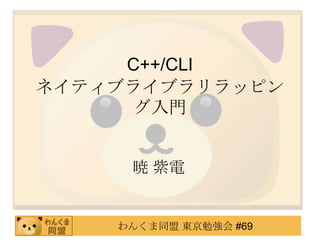
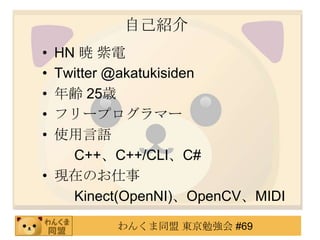
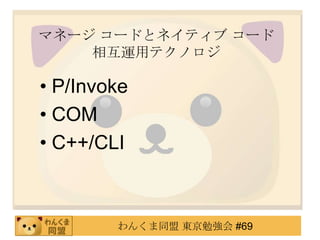
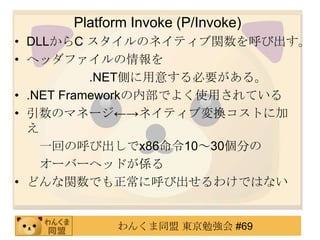


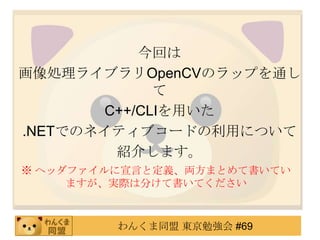
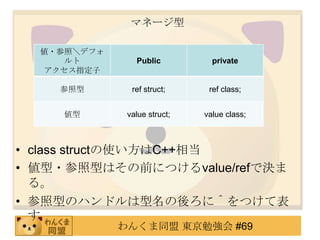
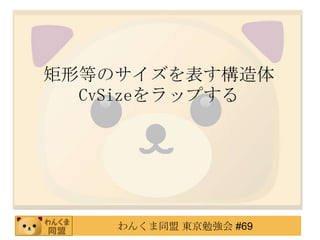
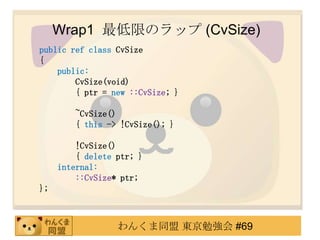
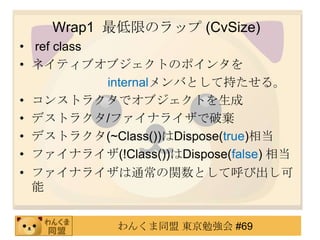
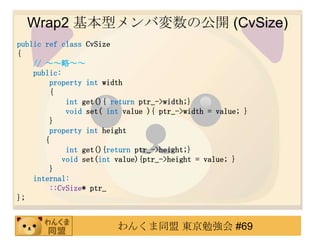
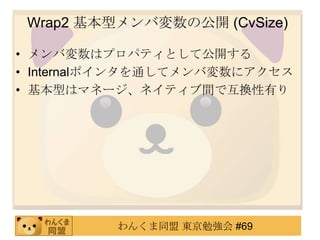

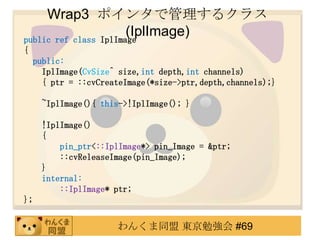


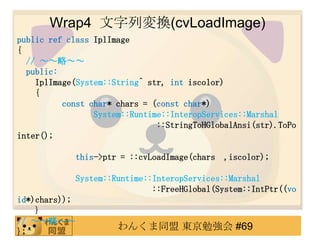


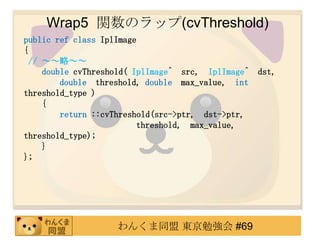
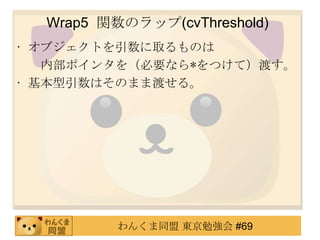


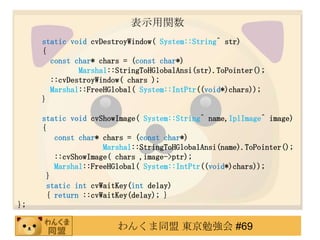
![実行コード C#
class Program
{
static void Main( string[] args)
{
GUI.cvNamedWindow( "window" , 1);
IplImage loadedImage = new IplImage( "wankuma.png” , 0);
GUI.cvShowImage( "window” , loadedImage);
GUI.cvWaitKey(0);
CvSize size = new CvSize();
size.width = loadedImage.width;
size.height = loadedImage.height;
IplImage img2 = new IplImage(size, loadedImage.depth,
loadedImage.nChannels );
わんくま同盟 東京勉強会 #69](https://image.slidesharecdn.com/t69ccli-130330001706-phpapp02/85/T69-c-cli-26-320.jpg)
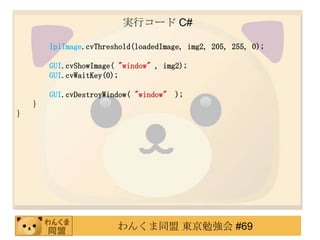

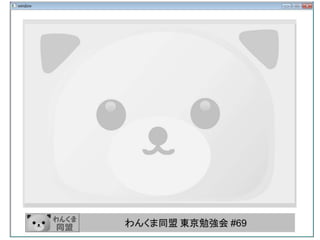


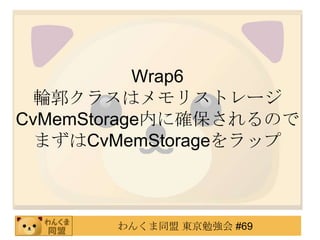

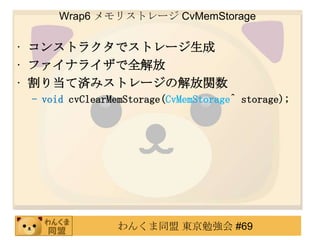

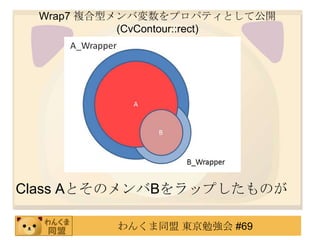
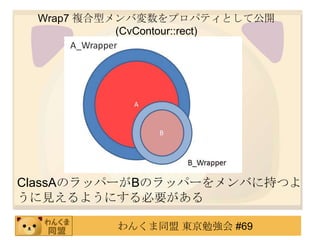


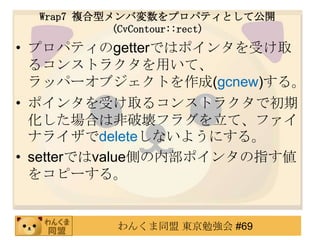
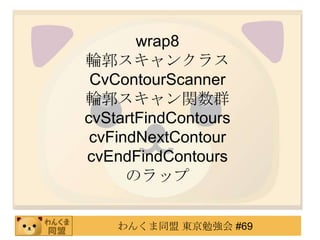
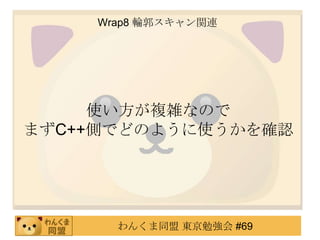
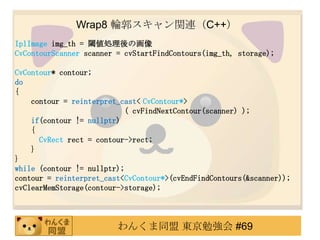
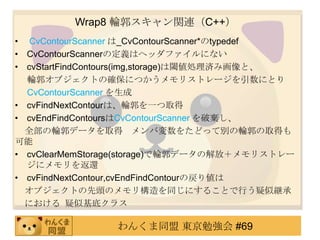
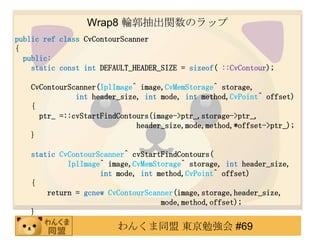

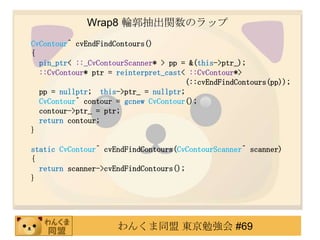
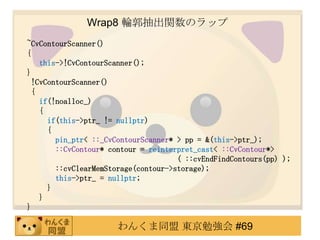
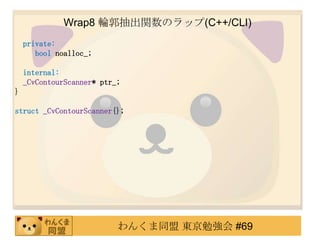
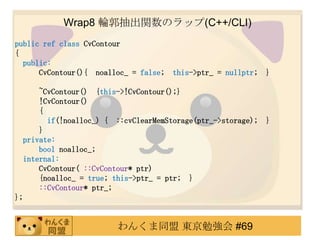
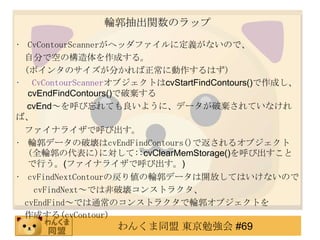

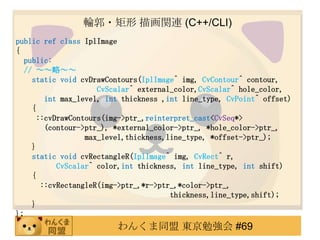
![続?実行コード C#
class Program
{
static void Main(string[] args)
{
// ~~略~~
CvMemStorage storage = new CvMemStorage(0);
CvContourScanner scanner = new CvContourScanner
(img2,storage,CvContourScanner.DEFAULT_HEADER_SIZE,
1,2,new CvPoint(0,0));
List<CvRect> list = new List<CvRect>();
CvContour scanningContour = null;
わんくま同盟 東京勉強会 #69](https://image.slidesharecdn.com/t69ccli-130330001706-phpapp02/85/T69-c-cli-54-320.jpg)
